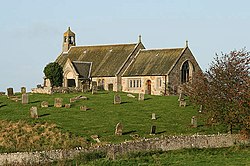Linton, Roxburghshire: Difference between revisions
Created page with "{{Infobox town |name=Linton |county=Roxburghshire |latitude= 55.530357 |longitude= -2.358792 |picture= Linton Parish Church - geograph.org.uk - 1021044.jpg |picture caption= L..." |
No edit summary |
||
| Line 4: | Line 4: | ||
|latitude= 55.530357 | |latitude= 55.530357 | ||
|longitude= -2.358792 | |longitude= -2.358792 | ||
|population=209 | |||
|picture= Linton Parish Church - geograph.org.uk - 1021044.jpg | |picture= Linton Parish Church - geograph.org.uk - 1021044.jpg | ||
|picture caption= Linton Church | |picture caption= Linton Church | ||
| Line 13: | Line 14: | ||
|dialling code=01573 | |dialling code=01573 | ||
}} | }} | ||
'''Linton''' is a small village and parish in [[Roxburghshire]] adjacent to the border with [[Northumberland]]. The village is situated a mile north of the village of [[Morebattle]]. | '''Linton''' is a small village and parish in [[Roxburghshire]] adjacent to the border with [[Northumberland]]. The village is situated a mile north of the village of [[Morebattle]]. Adjacent parishes are [[Sprouston]] to the north; [[Carham]] (in Northumberland) to the east; [[Yetholm]] and Morebattle to the south; and [[Eckford]] to the west. | ||
==History== | ==History== | ||
Latest revision as of 14:31, 14 May 2016
| Linton | |
| Roxburghshire | |
|---|---|
 Linton Church | |
| Location | |
| Grid reference: | NT774263 |
| Location: | 55°31’49"N, 2°21’32"W |
| Data | |
| Population: | 209 |
| Post town: | Kelso |
| Postcode: | TD5 |
| Dialling code: | 01573 |
| Local Government | |
| Council: | Scottish Borders |
| Parliamentary constituency: |
Berwickshire, Roxburgh and Selkirk |
Linton is a small village and parish in Roxburghshire adjacent to the border with Northumberland. The village is situated a mile north of the village of Morebattle. Adjacent parishes are Sprouston to the north; Carham (in Northumberland) to the east; Yetholm and Morebattle to the south; and Eckford to the west.
History
People have lived in the area since prehistoric times: on the summit of Linton Hill there is an Iron Age fort.[1]
Linton was a substantial village in the Middle Ages.[1] The Somerville family first appear in the records as being from Linton in 1136.[1] There was a tower built by the family close to the church, but it was destroyed by the forces of Henry VIII, during the Rough Wooing, and nothing now remains of it.[1]
Linton Church stands on top of a sandy mound, and used to be surrounded by water and marshland.[2] The history of the church dates back to the 12th century, but the current building dates from 1911 and like its predecessors it has no solid foundations.[2] The porch door has been inset with the "Somervail Stone" showing a knight fighting two beasts which is a link to the story of the Worm of Linton.[2] A local legend concerning the founding of the church states that a young man killed a priest and was condemned to death.[3] His two sisters pleaded for his life, which was granted on condition that they should sift as much sand as would form a mound on which to build a church.[3] The sisters succeeded in the task, the church was built, and the man was freed.[3]
Linton Loch was a substantial loch between Linton and Morebattle, but it was drained as part of the 19th century agricultural improvements in the area.[4]
The Worm of Linton
In legend, during the 12th century, the area of Linton was terrorised by a dragon-like monster known as The Linton Worm. One of the Somerville family—some say William while others cite John, both Lairds of Lariston—set out to put an end to the people's predicament. He arrived at Linton Loch or bog and slew the beast with a lance through the throat. The panel above the entry porch of the church is said to celebrate the event.[3] The Linton Worm is recorded by Walter Scott in his Minstrelsy of the Scottish Border.[5]
References
- ↑ 1.0 1.1 1.2 1.3 Linton Parish, Morebattle, Scotland. Retrieved 9 May 2014
- ↑ 2.0 2.1 2.2 Linton, Linton Morebattle Hownam Yetholm Parish Church of Scotland. Retrieved 9 May 2014
- ↑ 3.0 3.1 3.2 3.3 William Henderson, (1879) Notes on the folk-lore of the northern counties of England and the borders. London: W. Satchell, Peyton, & Co. 1879.
- ↑ History of Morebattle, Morebattle, Scotland. Retrieved 9 May 2014
- ↑ The Linton Worm, Morebattle. Retrieved 9 May 2014
| ("Wikimedia Commons" has material about Scottish Borders Linton, Roxburghshire) |
